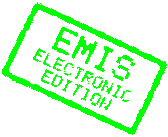On Residue Symbols and the Mullineux Conjecture
C. Bessenrodt1
and J.B. Olsson2
1Otto-von-Guericke-Universität Fakultät für Mathematik Magdeburg 39016 Magdeburg Germany
2Københavns Universitet Matematisk Institut Universitetsparken 5 2100 Copenhagen Ø Denmark
2Københavns Universitet Matematisk Institut Universitetsparken 5 2100 Copenhagen Ø Denmark
DOI: 10.1023/A:1008618621557
Abstract
This paper is concerned with properties of the Mullineux map, which plays a rôle in p-modular representation theory of symmetric groups. We introduce the residue symbol for a p-regular partitions, a variation of the Mullineux symbol, which makes the detection and removal of good nodes (as introduced by Kleshchev) in the partition easy to describe. Applications of this idea include a short proof of the combinatorial conjecture to which the Mullineux conjecture had been reduced by Kleshchev.
Pages: 227–251
Keywords: symmetric group; modular representation; Mullineux conjecture; signature sequence; good nodes in residue diagram
Full Text: PDF
References
1. G.E. Andrews and J.B. Olsson, “Partition identities with an application to group representation theory,” J. Reine Angew. Math. 413 (1991), 198-212.
2. C. Bessenrodt, “A combinatorial proof of a refinement of the Andrews-Olsson partition identity,” Europ. J. Combinatorics 12 (1991), 271-276.
3. C. Bessenrodt and J.B. Olsson, “On Mullineux symbols,” J. Comb. Theory (A) 68 (1994), 340-360.
4. B. Ford and A. Kleshchev, “A proof of the Mullineux conjecture,” Math. Z. 226 (1997), 267-308.
5. F. Garvan, D. Kim, and D. Stanton, “Cranks and t-cores,” Inv. Math. 101 (1990), 1-17.
6. G. James and A. Kerber, The Representation Theory of the Symmetric Group, Addison-Wesley, 1981.
7. A. Kleshchev, “Branching rules for modular representations of symmetric groups I,” J. Algebra 178 (1995), 493-511.
8. A. Kleshchev, “Branching rules for modular representations of symmetric groups II,” J. Reine Angew. Math. 459 (1995), 163-212.
9. A. Kleshchev, “Branching rules for modular representations of symmetric groups III,” J. London Math. Soc. 54 (1996), 25-38.
10. A. Kleshchev, “On decomposition numbers and branching coefficients for symmetric and special linear groups,” preprint, 1996.
11. A. Lascoux, B. Leclerc, and J. Thibon, “Hecke algebras at roots of unity and crystal basis of quantum affine algebras,” Commun. Math. Phys. (to appear).
12. K.C. Misra and T. Miwa, “Crystal base of the basic representation of Uq (sln),” Commun. Math. Phys. 134 (1990), 79-88.
13. A.O. Morris and A.K. Yaseen, “Some combinatorial results involving Young diagrams,” Math. Proc. Camb. Phil. Soc. 99 (1986), 23-31.
14. G. Mullineux, “Bijections of p-regular partitions and p-modular irreducibles of symmetric groups,” J. London Math. Soc. 20(2) (1979), 60-66.
15. G. Mullineux, “On the p-cores of p-regular diagrams,” J. London Math. Soc. (2) (1979), 222-226.
16. J.B. Olsson, “The number of modular characters in certain blocks,” Proc. London Math. Soc. 65 (1992), 245-264.
17. J.B. Olsson, Combinatorics and Representations of Finite Groups, Vorlesungen aus dem FB Mathematik der Universit\ddot at Essen, Heft 20, 1993.
2. C. Bessenrodt, “A combinatorial proof of a refinement of the Andrews-Olsson partition identity,” Europ. J. Combinatorics 12 (1991), 271-276.
3. C. Bessenrodt and J.B. Olsson, “On Mullineux symbols,” J. Comb. Theory (A) 68 (1994), 340-360.
4. B. Ford and A. Kleshchev, “A proof of the Mullineux conjecture,” Math. Z. 226 (1997), 267-308.
5. F. Garvan, D. Kim, and D. Stanton, “Cranks and t-cores,” Inv. Math. 101 (1990), 1-17.
6. G. James and A. Kerber, The Representation Theory of the Symmetric Group, Addison-Wesley, 1981.
7. A. Kleshchev, “Branching rules for modular representations of symmetric groups I,” J. Algebra 178 (1995), 493-511.
8. A. Kleshchev, “Branching rules for modular representations of symmetric groups II,” J. Reine Angew. Math. 459 (1995), 163-212.
9. A. Kleshchev, “Branching rules for modular representations of symmetric groups III,” J. London Math. Soc. 54 (1996), 25-38.
10. A. Kleshchev, “On decomposition numbers and branching coefficients for symmetric and special linear groups,” preprint, 1996.
11. A. Lascoux, B. Leclerc, and J. Thibon, “Hecke algebras at roots of unity and crystal basis of quantum affine algebras,” Commun. Math. Phys. (to appear).
12. K.C. Misra and T. Miwa, “Crystal base of the basic representation of Uq (sln),” Commun. Math. Phys. 134 (1990), 79-88.
13. A.O. Morris and A.K. Yaseen, “Some combinatorial results involving Young diagrams,” Math. Proc. Camb. Phil. Soc. 99 (1986), 23-31.
14. G. Mullineux, “Bijections of p-regular partitions and p-modular irreducibles of symmetric groups,” J. London Math. Soc. 20(2) (1979), 60-66.
15. G. Mullineux, “On the p-cores of p-regular diagrams,” J. London Math. Soc. (2) (1979), 222-226.
16. J.B. Olsson, “The number of modular characters in certain blocks,” Proc. London Math. Soc. 65 (1992), 245-264.
17. J.B. Olsson, Combinatorics and Representations of Finite Groups, Vorlesungen aus dem FB Mathematik der Universit\ddot at Essen, Heft 20, 1993.
